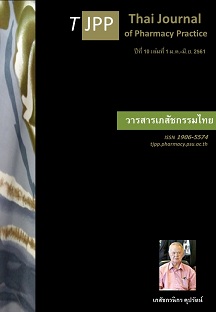ความปลอดภัยและประสิทธิภาพของการใช้ยาต้านเกล็ดเลือด 2 ชนิดร่วมกันและยาต้าน การแข็งตัวของเลือด 3 ชนิดร่วมกันในผู้ป่วย atrial fibrillation ที่มีการทำหัตถการรักษา โรคหลอดเลือดโคโรนารีย์ผ่านสายสวนและใส่ขดลวดค้ำยันในจังหวัดพิษณุโลก
Main Article Content
บทคัดย่อ
วัตถุประสงค์: เพื่อเปรียบเทียบความปลอดภัยของการเกิดภาวะเลือดออก และศึกษาอุบัติการณ์การเกิดเหตุการณ์ไม่พึงประสงค์ที่เกี่ยวข้องกับหัวใจและหลอดเลือดสมอง (Major adverse cardiac and cerebrovascular events หรือ MACCE) ในผู้ป่วยโรคหัวใจเต้นผิดจังหวะชนิด atrial fibrillation (AF) ที่ได้รับการทำหัตถการรักษาโรคหลอดเลือดโคโรนารีย์ผ่านสายสวน (percutaneous coronary intervention หรือ PCI) และใส่ขดลวดค้ำยันที่ได้รับยาต้านเกล็ดเลือด 2 ชนิดร่วมกัน (dual antiplatelet หรือ DAPT) และยาต้านการแข็งตัวของเลือด 3 ชนิดร่วมกัน (triple antithrombotic therapy หรือ TT) วิธีการ: เป็นการศึกษาแบบเก็บข้อมูลย้อนหลังและติดตามผู้ป่วยไปข้างหน้าเป็นระยะเวลา 1 ปี (retrospective cohort study) การศึกษาเก็บข้อมูลตั้งแต่ 1 มกราคม 2553 ถึง 30 กันยายน 2558 ในโรงพยาบาลพุทธชินราช พิษณุโลก และโรงพยาบาลมหาวิทยาลัยนเรศวร การศึกษาเก็บข้อมูลจากฐานข้อมูลอิเล็กทรอนิกส์ของโรงพยาบาล ตรวจสอบความถูกต้องของข้อมูลและเก็บข้อมูลอื่นที่ไม่มีในฐานข้อมูลอิเล็กทรอนิกส์จากเวชระเบียนผู้ป่วยนอกและหรือผู้ป่วยในร่วมด้วย ผู้เข้าร่วมการศึกษาทั้งหมด 232 คน แบ่งเป็น 2 กลุ่ม คือ กลุ่ม DAPT คือได้ยา aspirin ร่วมกับ clopidogrel จำนวน 127 คน และกลุ่ม TT ซึ่งได้ยา aspirin, clopidogrel และ warfarin ร่วมกันจำนวน 105 คน ตัวแปรผลลัพธ์ คือ การเกิดภาวะเลือดออกทั้งหมด การเกิดภาวะเลือดออกชนิดรุนแรงและไม่รุนแรง และ MACCE ผลการวิจัย: การเกิดภาวะเลือดออกรุนแรงพบในผู้ป่วย 4 ราย (ร้อยละ 3.15) และ 12 ราย (ร้อยละ 11.43) ในกลุ่มผู้ป่วยที่ได้รับยาแบบ DAPT และ TT ตามลำดับ (P=0.013) และผลรวมการเกิดภาวะเกิดเลือดออกทั้งหมดพบ 4 ราย (ร้อยละ 3.15) และ 21 ราย (ร้อยละ 20) ในกลุ่มผู้ป่วยที่ได้รับยาแบบ DAPT และ TT ตามลำดับ (P<0.001) ผลรวมของการเกิด MACCE ทั้งหมดพบ 57 ราย (ร้อยละ 44.88) และ 30 ราย (ร้อยละ 28.57) ในกลุ่มผู้ป่วยที่ได้รับยาแบบ DAPT และ TT ตามลำดับ (P=0.011) ส่วนผลรวมของการเกิดภาวะเลือดออกรุนแรงและผลรวมการเกิด MACCE ทั้งหมด (net clinical outcome หรือ NACE) พบ 61 ราย (ร้อยละ 48.03) และ 42 ราย (ร้อยละ 40) ในกลุ่มผู้ป่วยที่ได้รับยาแบบ DAPT และ TT ตามลำดับ (P=0.220) สรุป: การได้รับยาในกลุ่ม TT เพิ่มความเสี่ยงต่อการเกิดภาวะเลือดออก แต่มีผลลดการเกิด MACCE ได้เมื่อเทียบกับกลุ่ม DAPT นอกจากนี้ กลุ่ม TT เกิด NACE น้อยกว่ากลุ่ม DAPT แต่ไม่มีนัยสำคัญทางสถิติ ดังนั้นการได้รับยาแบบ TT จึงน่าจะมีประโยชน์ในผู้ปวย AF ที่ทำ PCI และใส่ขดลวดค้ำยัน ทั้งนี้อาจต้องมีการเฝ้าระวังการเกิดภาวะเลือดออกและพิจารณาปัจจัยอื่นที่มีผลต่อการใช้ยาร่วมด้วย
Article Details
ผลการวิจัยและความคิดเห็นที่ปรากฏในบทความถือเป็นความคิดเห็นและอยู่ในความรับผิดชอบของผู้นิพนธ์ มิใช่ความเห็นหรือความรับผิดชอบของกองบรรณาธิการ หรือคณะเภสัชศาสตร์ มหาวิทยาลัยสงขลานครินทร์ ทั้งนี้ไม่รวมความผิดพลาดอันเกิดจากการพิมพ์ บทความที่ได้รับการเผยแพร่โดยวารสารเภสัชกรรมไทยถือเป็นสิทธิ์ของวารสารฯ
เอกสารอ้างอิง
2. Soliman EZ, Safford MM, Muntner P, Khodneva Y, Dawood FZ, Zakai NA, et al. Atrial fibrillation and the risk of myocardial infarction. JAMA Intern Med. 2014;174:107-14.
3. Dewilde WJ, Oirbans T, Verheugt FW, Kelder JC, De Smet BJ, Herrman JP, et al. Use of clopidogrel with or without aspirin in patients taking oral anticoa- gulant therapy and undergoing percutaneous coronary intervention: an open-label, randomised, controlled trial. Lancet 2013;381:1107-15.
4. Camm AJ, Lip GY, De Caterina R, Savelieva I, Atar D, Hohnloser SH, et al. 2012 focused update of the ESC Guidelines for the management of atrial fibrillation: an update of the 2010 ESC Guidelines for the management of atrial fibrillation. Developed with the special contribution of the European Heart Rhythm Association. Eur Heart J. 2012;33: 2719-47.
5. Jedsadayanmeta A. Pharmacotherapy of atrial fibrillation. Bangkok: Focus printing; 2013.
6. Lip GY, Windecker S, Huber K, Kirchhof P, Marin F, Ten Berg JM, et al. Management of antithrom- botic therapy in atrial fibrillation patients presenting with acute coronary syndrome and/or undergoing percutaneous coronary or valve interventions: a joint consensus document of the European Society of Cardiology Working Group on Thrombosis, European Heart Rhythm Association (EHRA), European Association of Percutaneous Cardiovas- cular Interventions (EAPCI) and European Associa- tion of Acute Cardiac Care (ACCA) endorsed by the Heart Rhythm Society (HRS) and Asia-Pacific Heart Rhythm Society (APHRS). Eur Heart J. 2014; 35: 3155-79.
7. Windecker S, Kolh P, Alfonso F, Collet JP, Cremer J, Falk V, et al. 2014 ESC/EACTS Guidelines on myocardial revascularization: The Task Force on Myocardial Revascularization of the European Society of Cardiology (ESC) and the European Association for Cardio-Thoracic Surgery (EACTS) Developed with the special contribution of the European Association of Percutaneous Cardiovas- cular Interventions (EAPCI). Eur Heart J. 2014;35: 2541-619.
8. Wijns W, Kolh P, Danchin N, Di Mario C, Falk V, Folliguet T, et al. Guidelines on myocardial revascularization. Eur Heart J. 2010;31:2501-55.
9. Rubboli A, Magnavacchi P, Guastaroba P, Saia F, Vignali L, Giacometti P, et al. Antithrombotic management and 1-year outcome of patients on oral anticoagulation undergoing coronary stent implantation. Am J Cardiol. 2012;109:1411-7.
10. Gao F, Zhou YJ, Wang ZJ, Shen H, Liu XL, Nie B, et al. Comparison of different antithrombotic regimens for patients with atrial fibrillation under- going drug-eluting stent implantation. Circ J. 2010; 74: 701-8.
11. Mennuni MG, Halperin JL, Bansilal S, Schoos MM, Theodoropoulos KN, Meelu OA, et al. Balancing the risk of bleeding and stroke in patients with atrial fibrillation after percutaneous coronary intervention. Am J Cardiol. 2015;116:37-42.
12. Karjalainen PP, Porela P, Ylitalo A, Vikman S, Nyman K, Vaittinen MA, et al. Safety and efficacy of combined antiplatelet-warfarin therapy after coronary stenting. Eur Heart J. 2007;28:726-32.
13. Montalescot G, Sechtem U, Achenbach S, Andreotti F, Arden C, Budaj A, et al. 2013 ESC guidelines on the management of stable coronary artery disease: the Task Force on the management of stable coronary artery disease of the European Society of Cardiology. Eur Heart J. 2013;34:2949-3003.
14. Ruiz-Nodar JM, Marin F, Lip GY. Antithrombotic management and type of stent in atrial fibrillation patients undergoing percutaneous coronary inter- vention. Rev Esp
Cardiol. 2013;66:12-6.
15. Sullivan KM. Sample size for a cross-sectional, cohort, or clinical trial studies [online]. 2007 [cited Oct 15, 2015]. Available from: www.openepi.com/PDFDocs/SSCohortDoc.pdf.
16. Ruiz-Nodar JM, Marin F, Hurtado JA, Valencia J, Pinar E, Pineda J, et al. Anticoagulant and anti- platelet therapy use in 426 patients with atrial fibrillation undergoing percutaneous coronary inter- vention and stent implantation implications for bleeding risk and prognosis. J Am Coll Cardiol. 2008; 51:818-25.
17. Rao AK, Pratt C, Berke A, Jaffe A, Ockene I, Schreiber TL, et al. Thrombolysis in Myocardial Infarction (TIMI) Trial--phase I: hemorrhagic mani- festations and changes in plasma fibrinogen and the fibrinolytic system in patients treated with recombinant tissue plasminogen activator and streptokinase. J Am Coll Cardiol 1988;11:1-11.
18. Rossini R, Musumeci G, Lettieri C, Molfese M, Mihalcsik L, Mantovani P, et al. Long-term outcomes in patients undergoing coronary stenting on dual oral antiplatelet treatment requiring oral anticoagulant therapy. Am J Cardiol. 2008; 102: 1618-23.
19. Goto K, Nakai K, Shizuta S, Morimoto T, Shiomi H, Natsuaki M, et al. Anticoagulant and antiplatelet therapy in patients with atrial fibrillation undergoing percutaneous coronary intervention. Am J Cardiol. 2014;114:70-8.
20. Kang D, Yu C, Kim H, Cho J, Joo H, Choi R, et al. Triple antithrombotic therapy versus dual antiplatelet therapy in patients with atrial fibrillation undergoing drug-eluting stent implantation. Coron Artery Dis. 2015;26:372-80.
21. Sorensen R OJ, Charlot M, Gislason GH. Risk of bleeding related to antithrombotic treatment in cardiovascular disease. Curr Pharm Des. 2012; 18: 5362-78.


